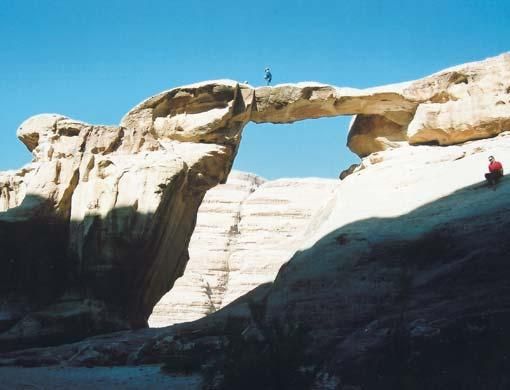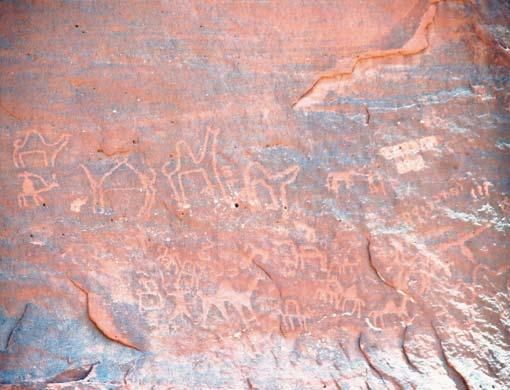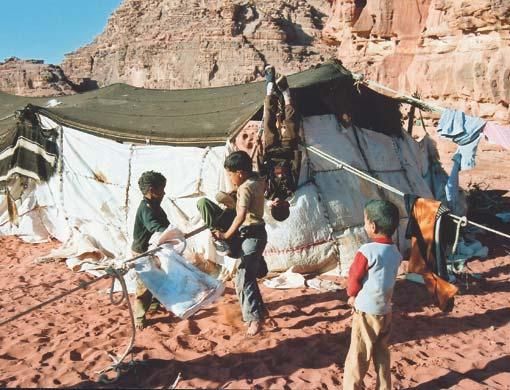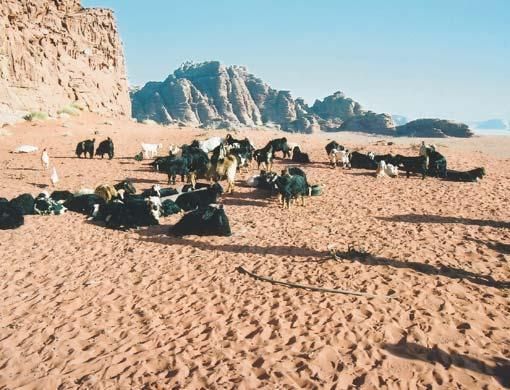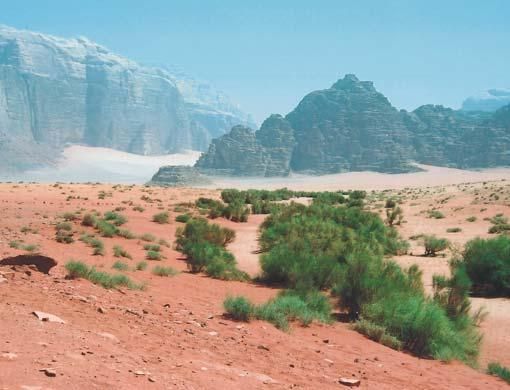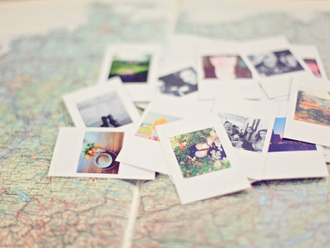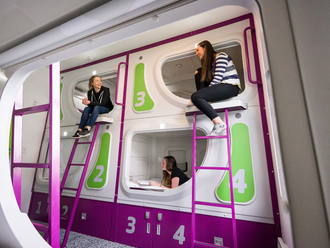The road that brought us to the protected area of Wadi Rum disappeared in the sands all of a sudden. And as I instinctively reached for the seat belt, especially after an experience of the caffeine-driven energy of dune-bashing in Dubai, Sabah, who was at the wheels, assured me it was not required. The key to enjoying the desert was slowing down to the pace of the desert, he said.
Return to nature
Wadi Rum is a land of coloured sands peppered by red cliffs and occasional Bedouin herders who are on the move from one grassy patch to another along with their livestock. But the lure of the desert holds more than visual pleasure.
It seems to appeal to the vagabond nature in humans, the need to forget the mechanical, daily existence and to return to nature. I reached Wadi Rum after days of whirlwind tours of Madaba, the town with mosaic maps of Christian lands dating back to the 5th century, cloyingly romantic Petra, and the imposing Crusader castle of Kerak.
The days were tiring. I needed to catch my breath before heading to the Red Sea town of Aqaba and bustling Amman. The desert stopover was supposed to be reserved for rest — and to experience, in a clichéd way, the Bedouin way of life.
Heart-felt welcome
But the 24 hours that I spent there added reality to the romance associated with the nomadic herders, an exotic viewpoint that overlooks poverty, dearth of employment opportunities and lack of education among women. Also, the sincere welcome into tattered tents on top of windswept dunes with a glass of sweetened tea was a humbling experience.
How many times have we honestly welcomed people who come to our homes unannounced? When Attayak Ali said "you are welcome" for a lunch of dates and canned tuna and chicken in the shade of huge cliffs in the middle of the desert, or for a night's stay at the camp, there was an earnestness in the voice which made you respectful of whatever you were being offered.
It is hard to ignore the Lawrence-of-Arabia stamp in Wadi Rum, which was the headquarters of Prince Faisal Bin Hussain and T.E. Lawrence during the Arab revolt against the Ottoman empire during the First World War.
There is Lawrence's House (a pile of bricks now), unrecognisable sets of the Lawrence of Arabia film, a cliff called Seven Pillars of Wisdom on which Lawrence named his book, and even Lawrence's Spring, or Ain Ash Shallaleh, which is actually a natural spring that existed long before Lawrence stepped into the region. It is said Lawrence drank from it once - as he did from many others. In fact, there are quite a few Lawrence's Springs around.
Activities
There are also traces of ancient civilisations in this caravan passageway, from pictographs to Thamudic, Nabatean and Arabic texts that have been carved on rock faces, as at Annafishiya. In Disi, near Wadi Rum, an Italian excavation revealed an early Nabatean settlement before this ethnic tribe moved on to Petra.
The Allat Temple lies at the foot of Jebel Rum. Originally built by the Ad tribe, it was remodelled by the Nabateans around 1BC. Thamudic inscriptions can be found on the temple walls and cover earlier Nabatean inscriptions, walls and columns.
Otherwise known as the Valley of the Moon, because of the cliffs that have been shaped like lunar rock formations by the winds, Wadi Rum is also carving its place on the hiking and rock-climbing map. Some ridges are 1,000 feet high, with domes smoothened by wind.
But commerce is yet to tarnish the famous hospitality of the residents. As dusk approaches, the Bedouin encampments are kindled and music from the oud starts wafting across the sands. Also with us was a couple from Denmark, some students from Oregon and California and the Rum natives.
Attayak Ali asked: "So what do you Indians do on such brilliant nights?" As I fumbled for something equally brilliant to say, he chuckled: "We just watch the moon".
Musical evening
Three more ouds came out from the robes and as night wore on over tea, coffee, mensaf and the flickering light of a lamp, the music rose and fell in a crescendo. Soon, more Bedouins appeared from other camps, tiny dots of light in the desert night, and many took turns to accompany Attayak Aouda, driven by the hypnotic rhythm. As a Welsh lover of Rum put it, 'silent Bedouin' is a contradiction in terms. What are the lyrics all about? "Lost love, what else?" winked Attayak Ali.
Did you know?
Wadi Rum has been the setting of various English films, apart from Lawrence of Arabia. It was used as the surface of Mars in Red Planet (2000). And scenes of Passion in the Desert were also shot here.
Go there... Wadi Rum
From the UAE
Amman is the closest airport.
From Dubai: Emirates flies daily. Fare from Dh1,570
Royal Jordanian flies daily. Fare from Dh1,570
Qatar Airways flies 6 times a week tvia Doha. Fare from Dh1,440
From Abu Dhabi: Etihad flies daily. Fare from Dh1,430
— Information courtesy: The Holiday Lounge by Dnata. Ph: 04 3166160
Information: Travel guide
- Visitors to Wadi Rum usually book a tour with one of the Bedouin guides. Among the recommended ones are: Attayak Ali (phone +962.795.899.723, e-mail info@bedouinroads.com); Attayak Aouda (phone +962.795.834.736, e-mail attayak@rumguides.com); and Atallah Sweilhin (phone/fax +962.3.203.3508, cellphone +962.795.802.108, e-mail rumhorses@yahoo.co.uk).
- The buses to and from Aqaba are quite infrequent and so are those from Petra, the two nearest towns to Wadi Rum. There is a bus from Aqaba to Wadi Rum that leaves at 11am, but it depends on the number of passengers the driver can manage. Ticket prices vary accordingly, more passengers means a lower price. There is another bus which leaves at 1pm and the last at 3pm.
- One can also take a bus to Rashidiya, or the Rum intersection, about 30km from Aqaba. Guides can pick clients from there if bookings are made in advance. There are taxis going to Rum — 4 Jordanian dinars (Dh21) or 5 dinars (Dh26), for a carload is the standard asking price.
- There is a daily bus from Petra which leaves around 8.30am and returns in the evening. A bus also leaves for Aqaba at 7.30am and, if there are many passengers, at 8.30am as well.
- I arranged for a mini bus that picked me up from a hotel in Petra at 6.30am. I had this arranged with the hotel manager and he had called up the bus driver the previous night. Again, the ticket prices vary with the number of people on board. I paid 5 dinars (Dh26) along with six other people in the bus.


